The MGA With An Attitude
MGA FUEL PUMP, General Information -- FP-100
At 11:21 AM 1/4/06, Michael Sloan wrote:
>"I've been thinking about fuel pumps, and positive ground. I assume that it is necessary to change to a negative ground if I want to use solid state .... The question is, should I? "
It is not necessary, but probably is a good idea to switch to negative earth, especially if you want to install any modern electronic device. Then in the future you can be free to install any additional electronic device with negative earth.
>"I need a fuel pump, so I guess I have to make this decision before I order one."
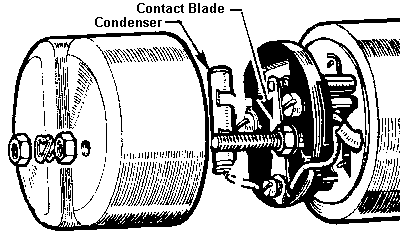 Very early MGA fuel pumps had "bare" contact points and were not polarity sensitive. These would be rare today, because most have long since been replaced with something else. Later production MGA fuel pumps (or some replacements) may have a capacitor across the points for arc suppression, but are still not polarity sensitive. The capacitor is (most commonly) a metal can with one wire and a grounding bracket, or a metal can with two wires on opposite ends and a plastic sleeve.
Very early MGA fuel pumps had "bare" contact points and were not polarity sensitive. These would be rare today, because most have long since been replaced with something else. Later production MGA fuel pumps (or some replacements) may have a capacitor across the points for arc suppression, but are still not polarity sensitive. The capacitor is (most commonly) a metal can with one wire and a grounding bracket, or a metal can with two wires on opposite ends and a plastic sleeve.
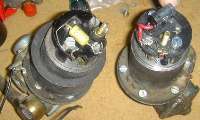
Capacitor on left, diode on right.
|
Later production fuel pumps for the MGB, and most modern replacement units, will have a diode across the points for arc suppression. Those are polarity sensitive, but you can reverse the polarity by reversing the diode. Some more recent replacement pumps use a metal oxide varistor (or transient voltage suppressor) which is not polarity sensitive. The MOV looks like a small disk with two edge wires same color.
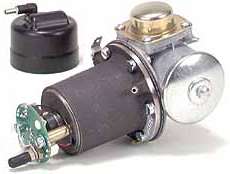 To confuse the issue, the diode pumps had an 'AZX' prefix. When the diode was replaced by the MOV they use the same part number as the earlier negative earth diode pump. Some sources still quote these as polarity sensitive, and even the supplier SU Burlen were confusing at one time as the box stated 'dual polarity' but the instructions inside stated 'All AZX pumps are polarity sensitive'. The only way to be sure is to remove the electrical end cap for a peek inside.
To confuse the issue, the diode pumps had an 'AZX' prefix. When the diode was replaced by the MOV they use the same part number as the earlier negative earth diode pump. Some sources still quote these as polarity sensitive, and even the supplier SU Burlen were confusing at one time as the box stated 'dual polarity' but the instructions inside stated 'All AZX pumps are polarity sensitive'. The only way to be sure is to remove the electrical end cap for a peek inside.
Modern SU fuel pumps with electronic control (above right) are polarity sensitive and cannot be changed over except by replacing the circuit board (which may not be available separately).
>"Moss Does have a "SU Double Pump, Points type" ($400) that is not polarity sensitive, as well as a cheaper "Fuel Pump, Electric" ($100) that is not polarized."
The double ended SU fuel pump is a waste of money unless you have a race engine tuned for more than 120 HP output (and relatively more fuel demand).
SU fuel pumps have internal ground to pump body. The pump body must have a ground return to chassis. There should be an external black wire running from a mounting bolt on the pump mounting bracket, past the rubber isolator mounts, and connecting to the chassis for ground return. On the MGA the grounding point is one of the floor board bolts half way up the end of the rear vertical floor board (just above the fuel pump) . Attach the wire here with a hex nut. This wire is usually not included with a replacement wiring harness. It needs to be 18-gauge Black, about 10-inches long with a ring lug on both ends. One ring to fit the 1/4-BSF bolt on the fuel pump, and the other ring to fit the 5/16-UNF bolt in the floor board.
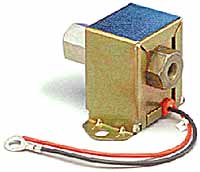
The little square Facet brand electronic fuel pump is very noisy. You can cut the noise down considerably with rubber mounting isolators. If you really want that type of fuel pump, you can buy cheaper it elsewhere. Let Google do the walking.
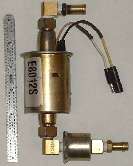
Many modern non-SU replacement fuel pumps are polarity sensitive, but can be used with either polarity by simply switching the wires. If you want a cheaper non-original fuel pump, I suggest this one.
>"I had the points vs electronic discussion on a board, but there were clearly 2 camps of thought on the issue.
Sure enough, another religious war. Those in favor of originality will wage war with lots of stories about how reliable the original SU fuel pump can be. But the simple fact that these discussions exist at all is indicative of the number of people who have problems with them.
The number one problem with the original SU fuel pump is corrosion of the contact points if it is left idle for a long time, such as six months winter storage. When you want to start it up in the spring you might need to clean the contact points before the fuel pump will run. Having to do that just once is enough to convince some people that the SU pump is unreliable. Having to do it once every year might cause anyone to switch.
There are a few other failure issues with SU pumps, but most of them are related to having many decades of age and/or use, nothing a good rebuild wouldn't fix. You can also get a new solid state SU pump, or a solid state conversion kit for your old SU pump, which will eliminate all problems related to contact points. Unfortunately. this also introduces some new problems of reliability and limited life of the solid state parts.
This leads to two different life styles and different philosophy. If the original points type pump fails to work, you can usually fiddle with the points a little, and it will ultimately get up and run well enough to get you home. If the solid state module fails on the road, you're just stuffed unless you carry replacement parts. This may be okay for modern appliance drivers who carry a cell phone and auto club card and don't mind waiting for a tow truck and possible delays for service or parts. (The same folks might also leave the spare tire home to allow more luggage space).
If you intend to convert to a solid state fuel pump, you might think about buying two sets of parts, one to install and one to carry as a spare with your traveling tool kit. Or you might carry the parts to convert it back to contact points in case of failure.
I personally am not terribly concerned about doing a little periodic maintenance on a vintage car. My ultimate measure of reliability is the probability of getting to my destination every day, or being stranded on the road in need of a tow. This was particularly important when I headed for Alaska and did 19,000 miles in 8 weeks, and much of that driving was 300 miles or more from the nearest assistance.
I do not use solid state ignition. I do use an aftermarket solid state fuel pump. But the fuel pump I use seems to have a friendly failure mode which will not leave me stranded. I will carry a spare fuel pump for a road trip more than 10,000 miles, or perhaps venturing into desolate areas. I did not carry much spare parts for the dash to Key West from Chicago for spring break, which was 3800 miles in 10 days. The universal fuel pump is available off the shelf in virtually any local auto parts store.
|
 To confuse the issue, the diode pumps had an 'AZX' prefix. When the diode was replaced by the MOV they use the same part number as the earlier negative earth diode pump. Some sources still quote these as polarity sensitive, and even the supplier SU Burlen were confusing at one time as the box stated 'dual polarity' but the instructions inside stated 'All AZX pumps are polarity sensitive'. The only way to be sure is to remove the electrical end cap for a peek inside.
To confuse the issue, the diode pumps had an 'AZX' prefix. When the diode was replaced by the MOV they use the same part number as the earlier negative earth diode pump. Some sources still quote these as polarity sensitive, and even the supplier SU Burlen were confusing at one time as the box stated 'dual polarity' but the instructions inside stated 'All AZX pumps are polarity sensitive'. The only way to be sure is to remove the electrical end cap for a peek inside.  Very early MGA fuel pumps had "bare" contact points and were not polarity sensitive. These would be rare today, because most have long since been replaced with something else. Later production MGA fuel pumps (or some replacements) may have a capacitor across the points for arc suppression, but are still not polarity sensitive. The capacitor is (most commonly) a metal can with one wire and a grounding bracket, or a metal can with two wires on opposite ends and a plastic sleeve.
Very early MGA fuel pumps had "bare" contact points and were not polarity sensitive. These would be rare today, because most have long since been replaced with something else. Later production MGA fuel pumps (or some replacements) may have a capacitor across the points for arc suppression, but are still not polarity sensitive. The capacitor is (most commonly) a metal can with one wire and a grounding bracket, or a metal can with two wires on opposite ends and a plastic sleeve. 

